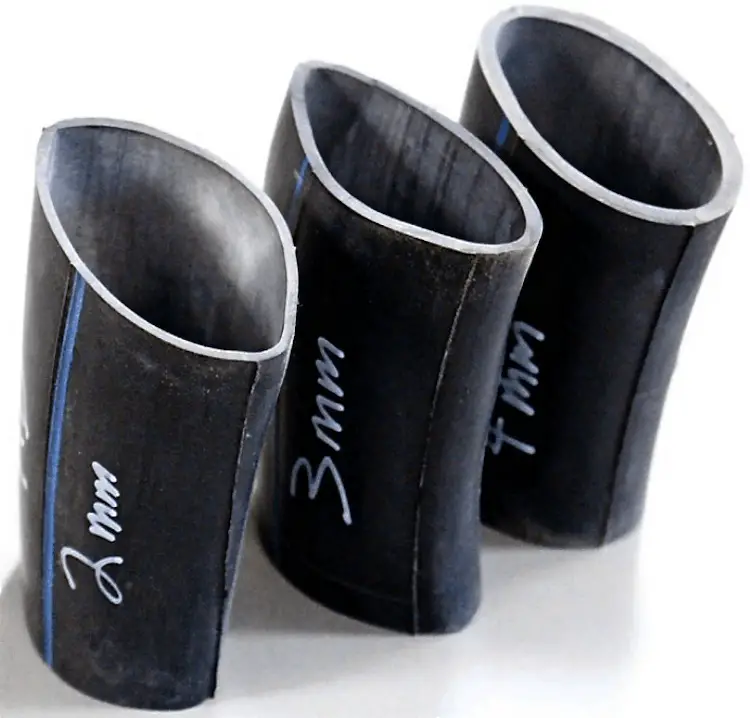The Week...10 Things You Need to Know
TEN THINGS Yous Demand TO KNOW ABOUT INNER TUBES

(ane) Synthetics. Inner tubes are a mix of natural and constructed safe. Natural rubber is more pliable and offers better resistance to punctures, but constructed rubber is cheaper. Expensive racing tubes generally take a college percentage of natural rubber to amend form to the tire and to prevent flats. At that place are also solid foam inserts (called mousse tubes) that simulate air pressure from a foam tube.
(2) Thin versus thick. For a motorcycle manufacturer, the inner tubes are an easy place to save weight and money. Most bikes come stock with thinner and cheaper tubes. Since the entire mass of an inner tube is rotating mass and unsprung weight, it is a prime identify to save weight. Conversely, almost every mill racer runs heavy-duty tubes (or mousses) to prevent flats.
(3) Sizing. Having the proper size inner tube for the tire is important for performance and preventing pinches. If you install a 110 inner tube in a 100 tire, the excess rubber will render it susceptible to beingness pinched with the tire irons. An inner tube that is as well small for a given tire will accept to be overinflated to make up the divergence in size. Overinflation weakens the ability of the inner tube to resist damage. It is possible to run a smaller tube to salvage weight, just information technology isn't recommended.
(iv) Performance. Inner tubes play a big office in the feel and performance of the tire. Inner tubes must exist the correct shape and size to sit down flush against the sidewall to give a adept, consistent experience. If there are places where the inner tube isn't in contact, the tire will feel mushy.
(v) Heat. Inflating an inner tube to the proper pressure non only ensures more sidewall strength, simply besides prevents compression flats. Every bit a rule of thumb, 12 to 14 pounds per square inch (psi) is the standard recommended pressure. Keep in mind that as the tire heats up during functioning, internal pressures can increment by equally much as four psi. This can be lessened by using nitrogen in the tubes to avoid the water content and oestrus expansion.

(6) Weight. Inner tubes are available in a variety of thicknesses to provide the advisable amount of protection confronting flats. The best known heavy-duty tubes are made by STI and distributed by Parts Unlimited. A sparse inner tube is approximately 1.5mm to 1.75mm thick. A heavy-duty tube is around 2mm to 3mm thick. And a super-heavy-duty tube is 3.5mm to 5mm thick. The weight of a sparse 110-90-19 inner tube is about 1230 grams (2.71 pounds), while a iii.5mm super-heavy-duty 110-90-19 weighs 1720 grams (3.79 pounds). For comparison purposes, a mousse tube tips the scales at 1950 grams (4.29 pounds).
(7) Baby pulverisation. If an inner tube isn't installed properly, it tin neglect. Using corn starch or baby powder on the inner tube during installation will reduce friction between the inner tube and the tire's carcass to help the tube last longer. Adding a little air to shape the inner tube before mounting the tire tin help forestall pinches during tire installation.
(8) Valve stem. The valve stem is the weak bespeak of a tube. Information technology is vulnerable to damage and leaks. The valve stem is vulcanized to the tube and tin be torn off if the tire spins on the rim, then be sure the rim lock is properly installed. Never tighten the nut on the valve stem down to the rim. If you go out it loose, the tire can spin a petty without ripping the valve stalk off the tire. Y'all can tell when the tire has spun on the rim considering the valve stem volition be artsy at an angle. Make certain to re-center the valve stem any time you run into it angled.
(9) Contaminants. An inner tube is fabricated to handle the abuse of a tire carcass, but non the exterior elements. If h2o or dirt gets between the tire and tube, it volition grate against the inner tube. Be sure that contaminants can't get in through the rim lock or valve stem holes. The prophylactic grommet that comes stock on Hondas is a good idea. Replacing the standard safe rim strip with duct tape makes it more difficult for water to become past the spoke nipples.
(x) Lifespan. Even if your inner tube hasn't gone flat, it tin wear out. Dunlop recommends irresolute tubes every six months. To know when to replace a tube, expect for chaffing, strings of prophylactic, discoloring (an old tube gets darker) or fading of any writing on the tube. Amazingly, patched tubes will piece of work besides as a new tube, merely the patch is a weak point and ideally should only be used in a pinch (pun intended).

Source: https://motocrossactionmag.com/10-things-you-need-to-know-about-inner-tubes/
0 Response to "The Week...10 Things You Need to Know"
ارسال یک نظر